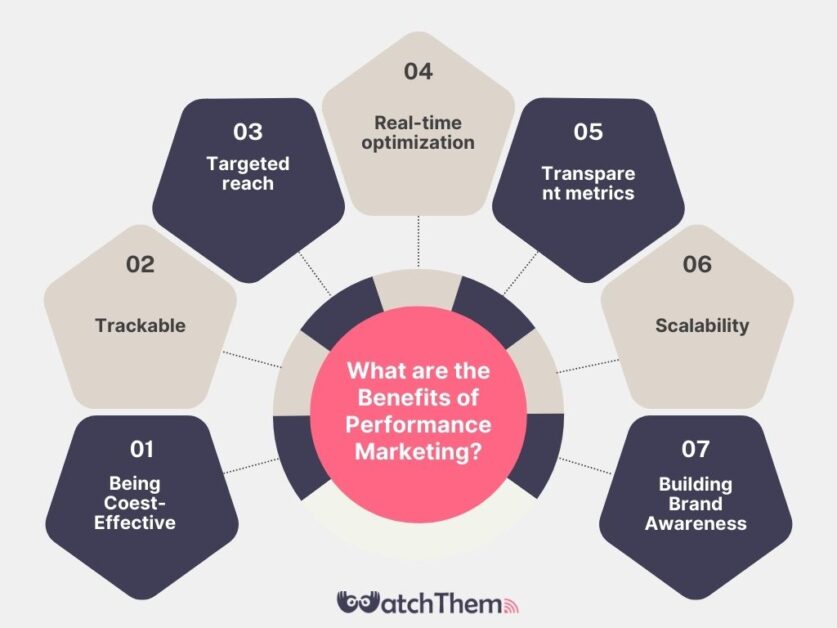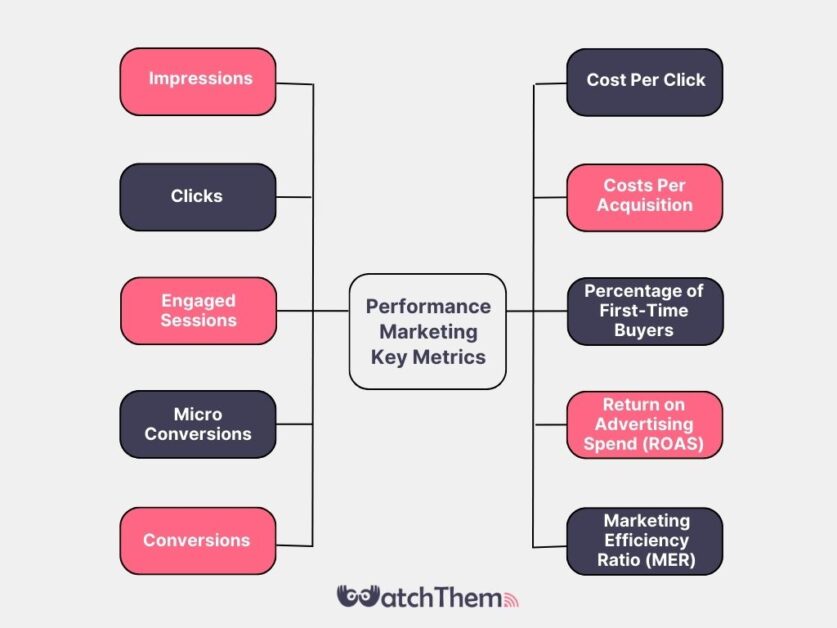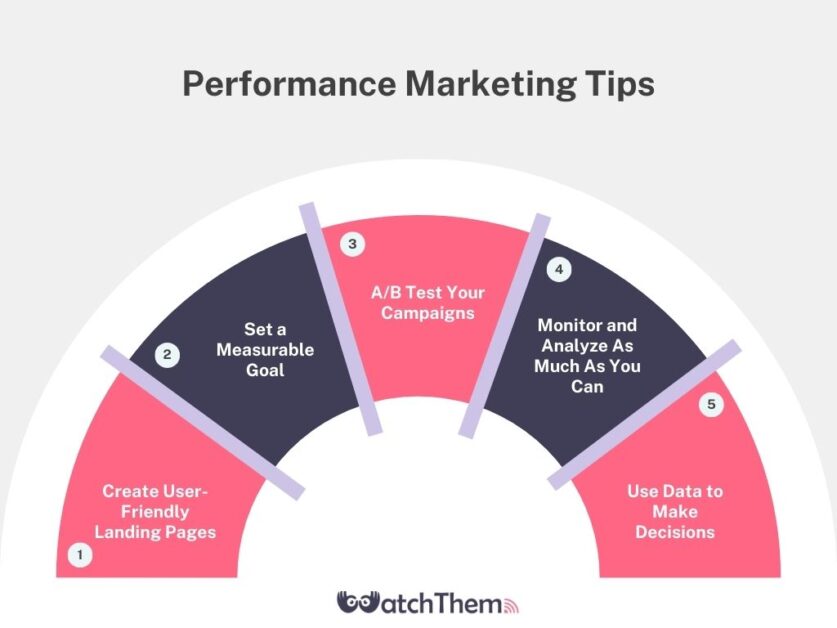Page Contents
In the realm of digital marketing, terms like digital marketing, paid marketing, and performance marketing often can get mixed up, making people wonder if they are different things or just connected parts of the same thing.
In this article, we will discover what is performance marketing. Then, we will explore the metrics and KPIs (Key Performance Indicators) crucial for its measurement and success.
What is Performance Marketing?
Let’s start with this common question ‘what is performance marketing?” Known as an important part of marketing, performance marketing refers to a part of marketing that focuses on getting results. It’s about paying for specific actions that are completed, like clicks on Google Ads or views on Facebook. You only pay when these actions happen, showing how well your marketing is performing.
What are the Benefits of Performance Marketing?
- Cost-effective: Performance marketing allows businesses to pay only for measurable results, such as clicks, leads, or conversions, optimizing their advertising budget for maximum ROI.
- Trackable: It’s easier to measure the result of performance marketing because all its metrics are trackable, helping you create more meaningful and practical reports.
- Targeted reach: By focusing on specific actions or outcomes, performance marketing enables businesses to target their audience more effectively, resulting in higher engagement and conversions.
- Real-time optimization: Performance marketing campaigns can be monitored and adjusted in real time based on performance data, allowing for continuous improvement and better results.
- Transparent metrics: Performance marketing provides clear and actionable metrics that measure the success of campaigns, helping businesses to understand what works and what doesn’t.
- Scalability: Performance marketing can be scaled up or down based on budget and goals, making it suitable for businesses of all sizes looking to drive results and achieve their objectives.
- Brand Awareness: By monitoring performance marketing KPIs, you can discover how well you have introduced your brand to your audience.


Performance Marketing Key Metrics
To make performance marketing work, you need to keep an eye on some important metrics to make sure your marketing is getting the best result. Here’s what they mean in simple terms:


1. Impressions
One of the important key metrics of performance marketing is ‘impressions. This tells you how many times your ad has been shown to people.
It’s like counting how many times someone has seen a billboard. However, unlike billboards, performance marketing is measurable. You can easily see the number of times your ad was displayed.
2. Clicks
When people see your ad, they either take an action or leave it. Clicks is the metric that shows how many people have clicked on your ad to learn more.
It’s like counting how many people walk into a store after seeing a sign outside. Clicks can indicate how interesting or convincing your ad has been.
3. Engaged Sessions
This goes beyond clicks and looks at how long people spend on your website after clicking. It’s like measuring how long someone stays in a store and whether they buy anything. Therefore, this metric can measure the effectiveness of your ad and user-friendliness of your website.
4. Micro Conversions
These are smaller actions people take on your website, like looking at different pages or searching for something. It’s like counting how many people pick up items in a store before deciding to buy.
By focusing on micro conversions, we can pave the way towards eventual conversion. These valuable user actions can hold crucial importance in achieving your goals.
Don’t overlook the power of small actions and instead leverage them to drive success.
5. Conversions
This is the ultimate goal. Conversion can measure how many people do what you want them to, like making a purchase or signing up for a newsletter. It’s when their journey is finished from viewing an ad and taking the action you wanted to get from that ad.
It’s like counting how many people actually buy something in a store.
6. Cost Per Click
You have paid an amount of money for your campaign, which is usually calculated per click. Cost per click (CPC) tells you how much you’re paying for each click on your ad. It’s like knowing how much you’re spending every time someone walks into your store because of a sign.
7. Costs Per Acquisition
This shows how much it costs you to get a new customer. It’s like figuring out how much it costs to bring someone into your store and make a purchase.
8. Percentage of First-Time Buyers
In the world of performance marketing, knowing what actions first-time buyer take can give you valuable information about how well your ad is performing.
In this case, one thing is important: looking at how many customers are buying for the first time. Analyzing the percentage of first-time buyers gives important information about how you are getting new customers and helps with planning for the future.
9. Return on Advertising Spend (ROAS)
Another important performance marketing metric is the Return on Advertising Spend or ROAS. It’s a metric used to evaluate the revenue generated for every dollar spent on advertising. It helps businesses understand how effective their advertising campaigns are in driving sales and achieving a positive return on investment.
ROAS is calculated by dividing the total revenue generated from advertising by the total advertising costs. A higher ROAS indicates that the advertising efforts are successful in generating revenue, while a lower ROAS may indicate that adjustments are needed to improve the campaign’s effectiveness.
10.Marketing Efficiency Ratio (MER)
The Marketing Efficiency Ratio is a metric used to measure the effectiveness of a company’s marketing efforts by comparing the cost of marketing activities to the revenue generated as a result of those activities.
The higher the Marketing Efficiency Ratio, the more effectively the company is utilizing its marketing resources to drive sales and achieve business goals.
Why These Numbers Matter
Understanding these numbers helps you see how well your performance marketing is working. Are you getting enough clicks? Are people spending time on your website? Are they buying anything? And most importantly, is it costing you too much to get new customers?
Therefore, it’s essential to analyze these metrics after each campaign you run to see how well it performed. Knowing which KPIs you should prioritize depends on your goals. You may not need to report all these metrics, but you should keep this data to use it for your next campaigns and compare the results.
Performance Marketing Tips
Knowing what is performance marketing and how it can help your business get better results from its campaigns is not the only thing you should consider. There are tips that can help you empower your performance marketing and its results.


1. Create User-Friendly Landing Pages
Part of your marketing goals depend on how well-designed your landing page is. In fact, you try your best to convince people to click on an ad and enter your website. But if you don’t have a great website, on which users can easily navigate and find what they look for, you will not reach any sales.
2. Set a Measurable Goal
It’s essential to set goals for your campaigns to know which metrics are more important to follow. All the metrics are measurable, but you should collect all of them and compare from time to time to see if the new method is performing better than the previous one.
3. A/B Test Your Campaigns
You should consider creating different campaigns with the same goal to see which works well. It can be two ads with different designs or copies. Then, you collect metrics on both ads to see which has received more clicks or which led to sale.
4. Monitor and Analyze As Much As You Can
Make sure to watch your marketing campaigns closely and be prepared to make changes if necessary. Performance marketing needs to be monitored and adjusted regularly.
5. Use Data to Make Decisions
Collect data and keep them for your next marketing. Performance marketing metrics are always useful for making different decisions.
FAQs
1. How Can Businesses Track and Measure Their Performance Marketing Campaigns?
First, it’s essential to set a clear objective for your campaign. For example, do you want to get more clicks or drive more sales. For each goal you should consider measuring different metrics. Then, you should set a timeframe for reaching your goal. In the end, create a reporting template with the metrics you want to measure after the period is over.
2. Is Affiliate Marketing the Same as Performance Marketing?
Although they are related, they are not the same. Performance marketing is a broader subject which can contain affiliate marketing. Generally, performance marketing is result-based and affiliate marketing result is always getting more sales. So, if you want to drive more sales, you can use affiliate marketing and measure its performance.
3. How Can Businesses Optimize Their Performance Marketing Strategies to Improve Results?
You should consider setting clear goals for your performance marketing. Then, test different methods, collect data, analyze them, and set a goal again for your next campaign. Analyzing data is the most important part that can help you improve your performance marketing results.
4. What is the Difference Between Performance Marketing and Digital Marketing?
Both performance marketing and digital marketing are considered part of the realm of online advertising. Each concept has different strategies and goals. However, performance marketing is part of digital marketing, which is measured based on the performance of an ad.
On the other hand, digital marketing focuses on marketing on digital channels. It can be social media marketing, content marketing, or SEO. The main goal of digital marketing is brand awareness. So, its KPIs may differ from performance marketing metrics.
Bottom Line
In conclusion, performance marketing is a results-oriented approach that focuses on paying for specific actions that drive desired outcomes, such as clicks, conversions, or sales. By measuring the direct impact of marketing efforts on key performance indicators, businesses can optimize their campaigns for effectiveness and efficiency.
Performance marketing allows for a more targeted and cost-effective strategy, as companies only pay for successful outcomes, ensuring a higher return on investment and maximizing marketing effectiveness.

